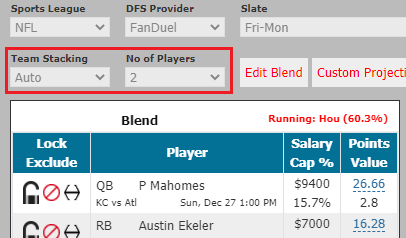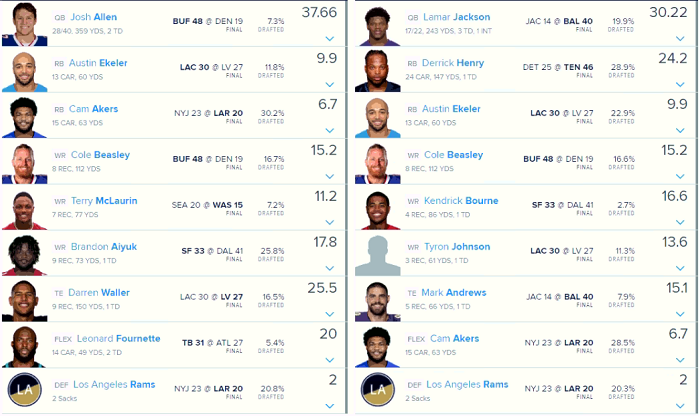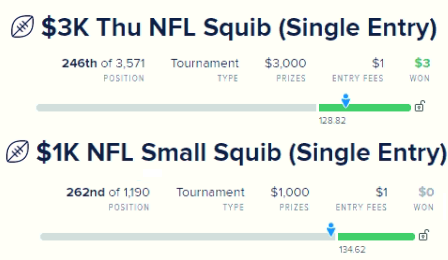ASL's founder, Leonard LaPadula, uses ASL's Auto Team Stack feature to set two FanDuel NFL lineups. Here are the results.
Typically when I enter multiple lineups into a contest I try various strategies using the ASL pro option settings and run the ASL multi-lineup generator.
However, I decided to enter two different $1 single-lineup contests in the Dec 17, THU-MON slate. Since this is a full roster slate, I could now consider what strategy I wanted to use to build the two lineups. I decided I wanted to enter two lineups created by using team stacking with a depth or two, each with a different quarterback.
First, I ran the optimizer with Team Stacking set to Auto and No of Players set to 2. This image shows the DFS Optimizer running with these settings for the Dec 25 FRI-MON slate:

When Auto Team Stacking is enabled, it runs once for each team in the slate.
For my Dec 17 THU-MON slate, it produced a lineup that included the pairing of Josh Allen (QB) and Cole Beasley (WR) of the Buffalo Bills.
I then excluded Josh Allen from the Available Players table, and ran Auto Team Stacking again so that it will give me the second best team stacking combination. This time it gave me Lamar Jackson (QB) with Mark Andrews (TE) of the Baltimore Ravens.
When I am exploring, I always run with Excl Opp Defense off. This is because this feature causes the optimizer to run a bit slower. The ASL optimizer doesn't just calculate defense as a last lineup fill-in from among the remaining defenses that don't conflict with any offensive players, but it is a two-way exclusion. It might pick a defense because of value, and then exclude opposing offensive players. It finds the lineup that produces the most fantasy points for the given set of constraints.
However, when I am done exploring, I rerun with the final settings with Excl Opp Defense on. So I ran with Team Stacking set to Buf, No of Players set to 2 and Exclude Opp Defense on, and then again with Team Stacking set to Bal to get my two lineups.
The are the two lineups that the optimizer produced:

The goal of team stacking is to gain a small edge to increase the odds a lineup will push up into the higher rankings and win a greater return. The idea is that a quarterback and his receivers rise and fall together or that they have positive correlation. A quarterback's performance and the performance of receivers of other teams have no direct correlation. If our goal is just to have an above average score, then team stacking doesn't really help. However, in tournament contests, a lineup must do better than average to win.
Let's say a quarterback has a 1/3rd chance of performing below their projection, and a 1/3rd chance of performing near their projection, and a 1/3rd chance of performing above their projection. If a receiver has 100% correlation with the quarterback, he will under perform if the quarterback under performs and over perform if the quarterback over performs. In this case, the odds that both the quarterback and a receiver on the same team over perform their projection is 1/3rd since they rise and fall together. They don't actually have 100% correlation, so the odds are a bit less than 1/3rd that they both rise together, but the odds that they both rise together are greater than the odds of a quarterback and a receiver on two different teams both over perform. In this case, the odds that they both exceed their projected performance is 1/3rd x 1/3rd or only 1/9th.
It is the opposite idea of why it is often a good idea to exclude opposing defenses. We don't know that the opposing defense that we exclude will perform better or worse then their projection, but we know our offensive players can't score touchdowns without the opposing defense being negatively impacted. So we hope for a defense that performs well but not at the cost of our offensive players performing poorly.
So here is the result of the two lineups:

Josh Allen had a great night, and that lineup scored 145.96 fantasy points. Lamar Jackson had an average night and that lineup scored 133.52 fantasy points, missing a win by only 1.1 fantasy points. Both Cole Beasley and Mark Andrews had okay nights.
All-in-all I can't complain. I paid $2 in entry fees and won $3 back, or gained 50%.
Was this the best strategy for entering these two lineups? What would have happened if I had set the stacking depth to 3 instead of 2? I don't know the answers to these questions, but hopefully this provides you one more approach to think about for setting lineups that work together to give a good chance to win.